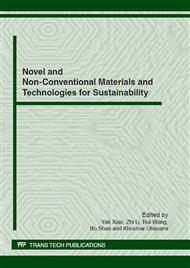[1]
ABNT NBR 5019; Escória – Especificação. (1982).
Google Scholar
[2]
ABNT NBR 5739; Concreto – Ensaio de compressão de corpos-de-prova cilíndricos. (2007).
Google Scholar
[3]
ABNT NBR 7211; Agregados para Concreto. (2005).
Google Scholar
[4]
ABNT NBR 9780, Peças de Concreto para Pavimentação – Determinação da Resistência à Compressão. (1987).
Google Scholar
[5]
ABNT NBR 9781, Peças de Concreto para Pavimentação - Especificação. (1987).
Google Scholar
[6]
ABNT NBR 10004; Resíduos Sólidos – Classificação. (2004).
Google Scholar
[7]
ABNT NBR 10005; Procedimento para Obtenção de Extrato Lixiviado de Resíduos Sólidos. (2004).
Google Scholar
[8]
ABNT NBR 10006; Procedimento para Obtenção de Extrato Solubilizado de Resíduos Sólidos. (2004).
Google Scholar
[9]
ABNT NBR 10007; Amostragem de Resíduos Sólidos. (2004).
Google Scholar
[10]
CETESB; Resíduos Sólidos Industriais. São Paulo, (1985).
Google Scholar
[11]
CETESB; Procedimentos para Gerenciamento de Areia de Fundição. São Paulo, (2007).
Google Scholar
[12]
CLAUDIO, J.R.; Resíduos Sólidos Perigosos – Solidificação de Lamas Tóxicas com Cimentos. Dissertação de Mestrado, Escola Politécnica – USP, São Paulo, (1987).
Google Scholar
[13]
CONNER, J.R.; Chemical Fixation and Solidification of Hazardous Wastes. Van Nostrand Reinhold, New York, (1990).
Google Scholar
[14]
CONNER, J.R. & HOEFFNER, S.L.; The History of Stabilization/Solidification Tecnology. Critical Reviews in Environmental Science and Tecnology, pp.325-396, EUA, (1998).
DOI: 10.1080/10643389891254241
Google Scholar
[15]
CONNER, J.R. & COTTON, S. & LEAR, P.R.; Chemical Stabilization of Contamined Soils and Sludges Using Cement By-products. Cement Industry Solutions to Waste Management, Proceedings, p.73, Calgary, (1992).
DOI: 10.1002/chin.199427317
Google Scholar
[16]
DANIALI, S.; Solidification/Stabilization of Heavy Metals in Latex Modified Portland Cement Matrices. Journal of Hazardous Materials, V. 24, n. 2-3, pp.225-230, (1990).
DOI: 10.1016/0304-3894(90)87012-7
Google Scholar
[17]
GIOCONDO CESAR, A.C.; Desenvolvimento de Blocos Confeccionados com Escória Proveniente da Reciclagem do Aço. Dissertação de Mestrado. EESC-USP, (2008).
DOI: 10.11606/d.18.2008.tde-13032009-084743
Google Scholar
[18]
HANNA, R.A.; Estudo da Estabilização por Solidificação de Produtos Tóxicos em Cimento Portland: Uma Análise em Nível Microestrutural. Tese de Doutorado, EPUSP, São Paulo, (1996).
DOI: 10.11606/t.42.2019.tde-12042018-141555
Google Scholar
[19]
JOHN, V.M. & CINCOTTO, M.A. & AGOPYAN, V.; Novos Mercados para as Escórias de Alto-forno. V Encontro Regional de meio Ambiente na Indústria Siderúrgica. Vitória-ES. Anais. (1995).
Google Scholar
[20]
LEI Nº 12305, DE 2 DE AGOSTO DE 2010. Institui a Política Nacional de Resíduos Sólidos; altera a Lei no 9. 605, de 12 de fevereiro de 1998; e dá outras providências.
DOI: 10.1590/0034-716719720002000016
Google Scholar
[21]
MACKAY, M. & EMERY, J.; Stabilization/Solidification of Contamined Soils and Sludges Using Cementitious Systems. Cement Industry Solutions to Waste Management, Proceedings, p.135, Calgary, (1992).
Google Scholar
[22]
MASUERO, A.B. & VILELA, A.C. & DAL MOLIN, D.; Emprego de Escória de Aciaria Elétrica como Adição a Concretos. UFRS, (2001).
Google Scholar
[23]
MERRITT, S.D.; Applications of Soil and Cement Chemistry to Stabilization/Solidification. Transportation Research Record, n. 1424, pp.1-7, (1993).
Google Scholar
[24]
OLIVEIRA, R.C.; Encapsulamento de Areia de Fundição de Descarte em Matriz de Cimento. Dissertação de Mestrado, EESC-USP, (1996).
Google Scholar
[25]
PABLOS, J.M.; Utilização do Resíduo Sólido Gerado pelo Descarte das Areias de Fundição Aglomeradas com Argila no Setor de Construção Civil. Dissertação de Mestrado, EESC-USP, (1995).
DOI: 10.11606/t.18.2008.tde-27022009-093112
Google Scholar
[26]
PABLOS, J.M.; Estudo para a Reutilização do Resíduo Sólido Constituído pelas Areias de Fundição Aglomeradas com Argila, através da Técnica de Solidificação/Estabilização em Matrizes de Cimento Portland, para Aplicação no Setor da Construção Civil, Tese de Doutorado, EESC-USP, (2008).
DOI: 10.11606/t.18.2008.tde-27022009-093112
Google Scholar
[27]
POON, C.S. & CLARCK, A.I. & PERRY, R.; Permeability Study on the Cement Based Solidification for the Disposal of Hazardous Wastes. Cement and Concrete Research, V. 16, pp.161-172, EUA, (1986).
DOI: 10.1016/0008-8846(86)90132-8
Google Scholar
[28]
SAITO, L.M. & LEÃO, M.L.G. & NETO, P.P.C.; Encapsulamento de Resíduos Industriais Perigosos. 130 Congresso Brasileiro de Engenharia Sanitária e Ambiental, Anais, Maceió, (1985).
DOI: 10.5151/chemeng-cobeq2014-0843-23375-158456
Google Scholar
[29]
SENAI; Areias de Fundição Aglomeradas com Argila. Publicação Técnica, Departamento Regional de Minas Gerais, Belo Horizonte, (1987).
Google Scholar
[30]
U.S. EPA; Solidification/Stabilization of Inorganics and Organics. Engineering Bulletin, EUA, (1991).
Google Scholar
[31]
U.S. EPA; Universal Treatment Standards for Organic Toxicity Characteristics Wastes and Newly Listed Wastes. Land Disposal Restrictions Phase II, 40CFR148, pp.260-261, 264-266, 268, 271, EUA, (1994).
Google Scholar
[32]
U.S. EPA; Handbook on In-situ Treatment of Hazardous Waste Contaminated Soil. U.S. EPA/540/2-90/002, Ohio, (1990).
Google Scholar


